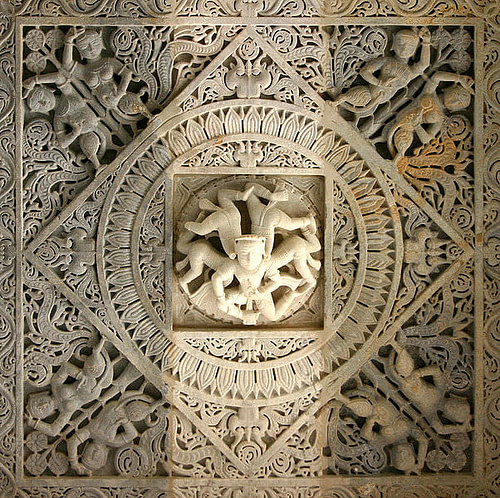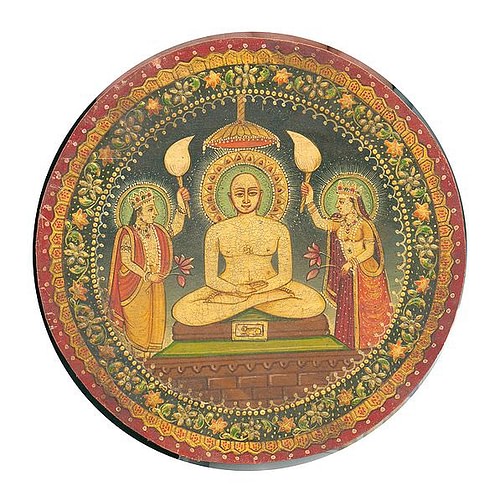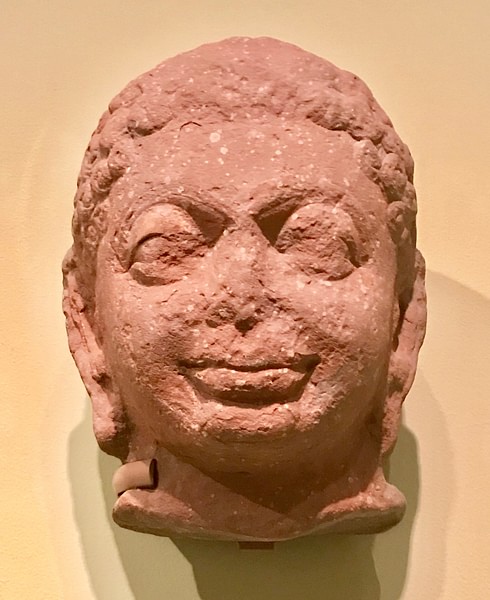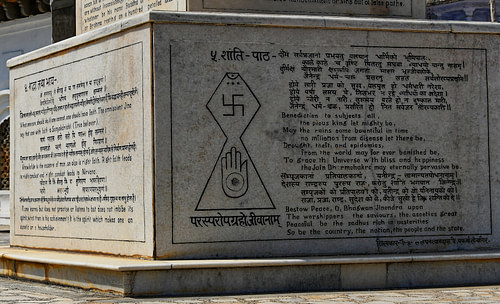
Jainism is one of the oldest religions in the world. The name comes from jiva (soul or life force but, capitalized, is also given as Spiritual Conqueror) as it maintains that all living things possess an immortal soul which has always and will always exist and this soul may be liberated from suffering by adhering to Jain tenets.
It originated in Northern India and spread from there to the south, but how it began is unclear. Its founder is often, inaccurately, identified as the sage Vardhamana (better known as Mahavira, l. c. 599-527 BCE), but he is actually only the 24th tirthankara (“ford builder”) of Jainism. Just as Hindus believe the Vedas have always existed and were only “heard” at a certain point in the past and written down, so Jains maintain that their precepts are eternal, recognized by 23 sages down through time, to finally be established by Mahavira in its present form.
It is a nontheistic religion in that it does not advocate a belief in a creator god but in higher beings (devas), which are mortal, and in the concept of karma directing one's present life and future incarnations; the devas have no power over a person, however, and are not sought for guidance or assistance in freeing one's self from karmic bondage. In Jainism, it is up to each individual to attain salvation – defined as release from the cycle of rebirth and death (samsara) - by adhering to a strict spiritual and ethical code of behavior. This code is based on the Five Vows (articulated in the foundational work, the Tattvartha Sutra):
- Ahimsa (non-violence)
- Satya (speaking the truth)
- Asteya (non-stealing)
- Brahmacharya (chastity or faithfulness to a spouse)
- Aparigraha (non-attachment)
The Five Vows direct one's thoughts and behavior since it is believed that, as one thinks, so will one do. It is not enough, therefore, to simply abstain from violence or lying or stealing; one must not even think of such things. If one adheres to this discipline, one will escape the cycle of samsara and achieve liberation. Once one has accomplished this, one becomes a tirthankara, a “ford builder” (as in, one who builds a ford or bridge over a river) who can show others how to securely cross the currents of life by shedding desire, freeing one's self from ignorance, and refusing the temptations of the world. In Jainism, suffering is caused by ignorance of the true nature of reality, and liberation is achieved through spiritual awakening and then living the truth one has realized.
Mahavira's development of the faith was in response to a general movement in India in the 5th and 4th centuries BCE of religious reform in response to Hinduism, the dominant faith at that time, which some thinkers felt was out of touch with the people's spiritual and physical needs. Besides Jainism, there were many other philosophies or religious systems developed at this time (including Charvaka and Buddhism) which flourished for a time and then either gained ground or failed. Jainism was able to survive and attract adherents through royal patronage of political powers such as the Mauryan Empire (322-185 BCE), later survived persecutions under various Muslim rulers from the 12th-16th centuries CE, and also resisted efforts of Christian missionaries in the 19th century CE to continue as a vibrant faith up through the present day.
Origins & Development
The belief system which would eventually develop into Hinduism (known as Sanatan Dharma, “Eternal Order”, to adherents) arrived in the Indus Valley sometime prior to the 3rd millennium BCE when a coalition of Aryan tribes migrated to the region from Central Asia. Aryan referred to a class of people, not a nationality, and meant “free” or “noble”. The term had no association with Caucasians until the 19th and 20th centuries CE, and claims regarding an ancient “Aryan Invasion” of light-skinned peoples have long been discredited. These Aryans brought with them the Sanskrit language and, after assimilating with the indigenous people, this became the language of their sacred texts, the Vedas, which inform Hinduism.
An early version of Hinduism was Brahmanism, which claimed that the universe and world operated according to eternal rules set in motion by a being they called Brahman who not only caused everything to function as it did but was absolute reality itself. This reality – the Universe - “spoke” certain truths which were eventually “heard” by ancient sages and written down in Sanskrit, becoming the Vedas, set down sometime between c. 1500 - c. 500 BCE. The Vedas were chanted by the Hindu priests, who interpreted them for the people, but the majority could not understand Sanskrit, and this practice – and perceived problem – gave rise to religious reform movements.
The philosophical/religious belief systems which resulted fell into two categories:
- Astika (“there exists”) which accepted the Vedas as the highest spiritual authority
- Nastika (“there does not exist”) which rejected the authority of the Vedas and of the Hindu priests
The three nastika schools which continued to develop from this period were Charvaka, Buddhism, and Jainism. Jainism was championed by the spiritual ascetic Vardhamana who came to be known as Mahavira (“Great Hero”) but the events of his life, aside from this, are little known. His birthplace, sphere of influence, and death site are all disputed. It is said that he grew up the son of affluent parents who died when he was either 28 or 30 years old and, at that point, he renounced his wealth and all worldly possessions and lived the life of a religious ascetic for the next twelve years. Upon realizing the true nature of the soul and attaining omniscience (kevalajnana) he was recognized as a spiritual conqueror (Jina) and tirthankara, after which he began preaching the Jain vision.
According to Jain belief, however, Mahavira was not the founder of the faith, only another in a long line of enlightened sages who had shed their ignorance and realized the true nature of reality and the soul. The precepts of Jainism, it is claimed, are eternal; they were never initiated by any mortal but only “received” by the 24 enlightened sages who transmitted them to others. As noted, this is the same claim made by Hindus regarding the Vedas. Scholar Jeffrey D. Long comments:
Perhaps both traditions emerged simultaneously and interdependently, initiating from points of origin centered in different regions of the sub-continent, through a process of dialogue and mutual transformation and synthesis that continues to the present. (Jainism, 56)
Although it is commonly thought that Jainism developed from Hinduism, this claim is rejected by Jains themselves though maintained by Hindus and various scholars of religion.
Beliefs
Jainism holds that all living things are animated by an immortal soul caught in the cycle of rebirth and death caused by karmic matter which has accumulated through one's past actions. One's initial spiritual state attracted this karmic matter in the same way a bookshelf collects dust. Once the matter attaches to the soul, one is bound to incarnation after incarnation on the wheel of samsara which blinds one to the actual nature of the soul and reality. Scholar John M. Koller comments on the Jain vision of the soul:
The essence of the soul (jiva) is life and its chief characteristics are perception, knowledge, bliss, and energy. In its pure state when it is not associated with matter, its knowledge is omniscient, its bliss is pure, and its energy is unlimited. But the matter that embodies the soul defiles its bliss, obstructs its knowledge, and limits its energy. This is why matter is seen as a fetter binding the soul. The word for matter, pudgala (mass-energy) is derived from pum, meaning “coming together” and gala, meaning “coming apart”, and reveals the Jain conception of matter as that which is formed by the aggregation of atoms and destroyed by their disassociation. Matter refers both to the mass of things and to the forces of energy that structure this mass, making and remaking it in its diverse forms. The word “karma” means “to make”, and in Jainism it refers to the making and remaking of the karmic matter that embodies the soul…This view of karma as a material force distinguishes the Jain view from other Indian views that take karma to be only a psychological or metaphysical force. (33)
In Hinduism and Buddhism, karma is understood as action – which either encourages liberation or ties one more closely to samsara – whereas in Jainism it is a natural function of the soul's interaction with reality. The soul becomes clouded, again as with dust obscuring an object, cannot recognize its true nature, and, through this ignorance, accepts the illusion of life instead of its reality and condemns itself to suffering and death.
An interesting aspect of the faith – also held by Charvaka – is an emphasis on the limitations of perspective and, so, the inability of anyone to state a completely objective truth. The Jains use the parable of the elephant and the five blind men to illustrate this problem. Each of the blind men, summoned by the king to define an elephant which stands before them, touch different parts of the animal and come to their own conclusions. To one, who touches the ears, an elephant is a large fan; to another who touches a leg, it is a stout post; to another, who touches the side, it is a wall, and so on. Each blind man is limited by perspective and individual interpretation in the same way each human being is by the limits of what they can understand in their dreaming state of subjective values, ignorance, and illusion.
In order to awaken and achieve liberation from matter, one must take the Five Vows and then follow through with actions which proceed from them. These actions lead one on a 14-stage path from ignorance and bondage to enlightenment and freedom.
Scriptures, Sects, & Practices
This path is suggested by the Jain scriptures – the Agamas and, according to some, Purvas – believed to have been “heard” from the universe and transmitted orally from generation to generation by the tirthankaras. Besides the Tattvartha Sutra (composed 2nd-5th centuries CE) there are also other scriptures, not accepted by all Jains, such as the Upangas, Chedasutras, Mulasutras, Prakinasutras, and Culikasutras passed down by oral tradition until committed to writing. Long comments:
The problem with oral transmission is that, if those who carry the knowledge of a text in their minds die before passing that knowledge on to others, or after passing it on only partially, that knowledge is forever lost. It is not unlike a situation in which every copy of a particular book is destroyed…This seems to have been the situation of the early Jain community and the reason the decision was finally taken to put their textual tradition into a written form [during the time of Chandragupta, r. c. 321 - c. 297 BCE, of the Mauryan Empire]. (Jainism, 64)
Jains are divided into two primary sects (though there are others), the Digambara (“sky-clad”) and the Svetambara (“white-clad”) whose views of the faith differ significantly in that the Digambara are more orthodox, reject the authoritative Svetambara canon of scripture, believe that only men can attain liberation and that women must wait until they are incarnated as a male to do so, and their monks go naked, rejecting even the need for clothing in keeping with the tradition that Mahavira and his first 11 disciples owned nothing and wore nothing. The Svetambara clergy wear white, seamless clothing, believe they have retained most of the original scriptures transmitted by Mahavira, and recognize that women can attain liberation as well as men.
This liberation, as noted, is achieved in 14 steps which are based on the scriptures and the Five Vows:
- Stage 1: The soul languishes in darkness, ignorant of its true nature, and a slave to passions and illusion.
- Stage 2: The soul catches a glimpse of truth but is too mired in illusion to retain it.
- Stage 3: The soul recognizes its own bondage and tries to break free but is still bound to attachments and illusion and falls backwards to Stage 1.
- Stage 4: The soul, having recognized its bondage, yearns to break free again but is suppressing, rather than eliminating, its attachments and so remains bound.
- Stage 5: The soul has a flash of enlightenment and understands it must take the Five Vows and adhere to them in order to free itself from bondage.
- Stage 6: The soul is able to restrain its attachments and passions to a degree through the discipline of the Five Vows.
- Stage 7: The soul overcomes spiritual lethargy and is strengthened through meditation and observance of the Five Vows. Self-awareness grows as well as a grander vision of the nature of the soul itself and reality.
- Stage 8: Hurtful karma is discarded, self-control perfected, and deeper understanding achieved.
- Stage 9: More karmic debt is eliminated through conscious living and greater spiritual insight is attained.
- Stage 10: At this stage, one has eliminated attachments almost completely but is still attached to the concept of one's body-as-one's-self. This is understood as “greed for a body”, which one must overcome in order to progress.
- Stage 11: Here, one works on eliminating the identification of the self with the body and releasing all other attachments. One recognizes the transient nature of those people and objects one is attached to and releases them.
- Stage 12: All of the karma-producing passions have been eliminated at this point, including one's attachment to the body.
- Stage 13: Recognizing fully the nature of reality and of the soul, one engages in deep meditation to withdraw from all activity which might result in karma-producing passions and backsliding to an earlier stage.
- Stage 14: As one approaches death, one is freed from all karmic debt and experiences the liberation of moksha, complete understanding, wisdom, and total freedom from bondage. The soul is freed and will never be incarnated again on the earthly plane to experience suffering and death.
For some people, like the tirthankaras, Stage 14 is reached long before death (when they attain nirvana, release) and they are recognized as Spiritual Conquerors (they have completely mastered themselves) and “ford builders” who then teach others how to do as they have done. The key to this mastery is the combination of faith, knowledge, and action known as the Ratnatraya or Three Jewels:
- True Faith
- Right Knowledge
- Pure Conduct
True Faith, of course, is belief in the validity of the Jain vision; Right Knowledge is the understanding of the actual nature of the soul and reality; Pure Conduct is acting faithfully on the first two. This includes a respect for all living things and the natural world, which informs Jain vegetarianism. Jains, especially Jain monastics, will gently sweep the path before them so they do not inadvertently step on an insect and will wear face masks to prevent themselves from inhaling any so that not even the smallest of living things is harmed by them. A deep respect for nature and the lives of all animate and inanimate beings and aspects of life is integral to the Jain vision.
Jain Symbol
This vision is illustrated in the Jain symbol of the image of the urn-shaped form with one dot at the top, three beneath, the swastika, and the hamsa (upraised palm of the hand) with the mandala in the center and the inscription. This symbol is not ancient but was created in 1974 CE, on the 2,500th anniversary of Mahavira's nirvana, to represent the fullness of the Jain belief system.
The urn-shaped image represents the universe, the dot at the top symbolizes liberation from bondage, the three dots beneath represent the Three Jewels, the swastika – an ancient symbol of transformation before its appropriation by the Nazi Party of Germany in the 20th century CE – symbolizes the four states of existence: heavenly spirits, humans, demonic spirits, and subhuman spirits such as plants and insects, all on the wheel of samsara.
The swastika has also been interpreted to represent the true character of the soul: boundless energy, boundless happiness, boundless knowledge, and boundless perception and insight. The hamsa-image symbolizes the courage and commitment of non-violence and the mandala suggests samsara while the inscription in the palm of the hand is translated as “Souls provide service to one another” or “Life is joined by mutual support and interdependence” as the Jains believe that all of life is sacred and every aspect of the natural world is deserving of the utmost respect, love, and nurture.
Conclusion
Jain tradition holds that Chandragupta Maurya became a disciple of the sage Bhadrabahu (l. c. 367 - c. 298 BCE), who was the last monk to retain full oral knowledge of the scriptures before they were written down. Chandragupta patronized Jainism in Bhadrabahu's honor and helped to establish the religion just as his grandson, Ashoka the Great (r. 268-232 BE), would do for Buddhism. Later Hindu monarchs supported Jainism, even commissioning temples, and Siddhartha Gautama, the Buddha (l. c. 563-483 BCE), a younger contemporary of Mahavira, practiced Jain asceticism before attaining enlightenment and forming his own belief system.
Between the 12th-16th centuries CE, the Jains were persecuted by the invading Muslims who destroyed their temples or turned them into mosques and murdered Jain monks. Even the long-held value of Jain non-violence was suspended in cases where one had to defend one's self, one's family, or a sacred site from Muslim attacks. In the 19th century CE, British missionaries interpreted Jainism as a sect of Hinduism (which gave rise to the claim, still repeated today, that Jainism developed out of Hinduism) and attempted to convert the Jains with the rest of the population without much success.
Jainism survived both of these attempts at eradication and continued to thrive in India, eventually spreading to other nations around the world. Although most Jains still reside in India, there are about 5 million adherents worldwide from Australia to Europe, Japan, and the United States. Most of the famous Jain temples are still found in India such as Ranakpu Temple or Dilwara Temple in Rajasthan or the grand Gomateshwara Temple in Karnataka – which features the largest monolithic statue in the world – or the Hanumantal Temple in Jabalpur, where the celebration of the birthday of Mahavira is launched every year. Jains honor the tirthankaras or acharya (one of the five supreme devas and, incarnated, the founder of a monastic order) at regular worship services and encourage each other in the faith.
Many of the temples in India are famous pilgrimage sites for Jains owing to their various associations, but temples elsewhere in the world also serve an important function. The Jain Center of America, in Queens, New York, houses the Mahavir and the Adinath Temples and is a focal point of worship for the local Jain community. Through these sites, and others, Jainism continues its vision of non-violence, self-discipline, and respect for all living things in the present day just as in the ancient past.








